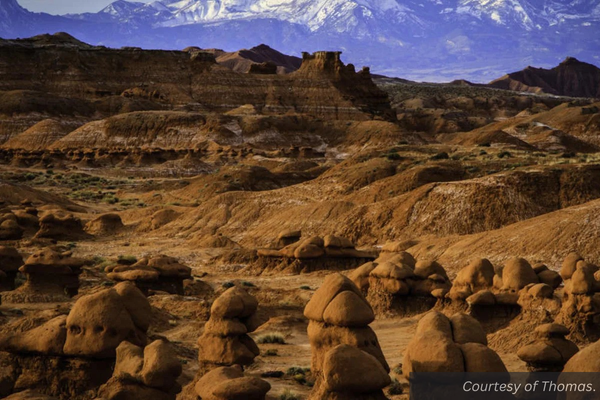For years, Southern Utahns have hiked, hunted, or just enjoyed the natural beauty of the Henry Mountains. This piece of land is home to the only free-roaming and huntable herd of American bison in the 48 contiguous United States. Recently, the BLM has developed a plan to limit access to the Henry Mountains and Fremont Gorge area. This proposal is the result of pressure from various environmental groups, mainly the Southern Utah Wilderness Alliance. To promote their special interests, they sue the BLM to force their ideals on the public. However, while doing so they hold the risk of taking away access to landscapes that have shaped local memories and livelihoods for generations.
Besides the chance to get a look at some bison, those who visit the Henry Mountains can find many natural and geological features. The mountains were formed from hardened molten diorite that forced itself up within the earth’s core, creating the five peaks that make up the Henry Mountains. Because of years of erosion in the mountains, the hardened diorite has become visible to us again, a sight worth seeing. Many other formations are also worth finding in this area, such as ‘Little Egypt’, which by the process of erosion of sandstone made little pyramids and sphinx-shaped rocks.
Sightseeing is not the only thing this land is known for. It’s also a place for camping, picnicking, prospecting, hiking trails such as mount ellen, and of course hunting. Not only can visitors hunt bison, a once in a lifetime opportunity, but the area is also home to one of the best mule deer populations in the country. For recreational hunters, the need to more easily access these lands with vehicles is a necessity, especially for removing large bison across miles of rough terrain. Restricting roads not only impacts OHV use, but also limits hiking, biking, and other non-motorized uses by making the public traverse larger distances to get to their favorite destinations. Currently, the Henry Mountain area is 78% open to OHV.
Although vehicles can create scars and damage to local vegetation, this is a matter of better enforcement of the existing laws, not a matter of making these areas inaccessible. In advocating against the closure of roads, Rich Klein wrote an article recently expressing his own opinion of how restricting access to roads affects people, namely veterans and those with physical and mental disabilities. He gives us a perspective of people who have different lifestyles and physical limitations. He proclaims that all people deserve to see this land, especially those who fought for it. He goes on to say that not everyone can hike the rough terrain of the off-road trails of this beautiful area. He also mentions briefly that the elderly and young children also deserve to see these beautiful and lush landscapes, and taking away OHV roads takes away the opportunities that the Henries Mountains have to offer.
The good news is, we can have our voices heard. If you know these lands well and want to see our roads unchanged, please send the BLM your opinions. At https://eplanning.blm.gov/eplanning-ui/project/94098/530 you may enter information such as how and why you use the roads you’re advocating for. Your comments will be sent to your email address for you to look over one last time before you submit them to the BLM. Your opinion matters, and together we can make sure that hunting, hiking, and other recreational opportunities will remain available to all.
– by Thomas Dodds (12th) Panguitch
Feature image: “Little Egypt” in the Henry Mountains Fremont Gorge area is full of little pyramids and sphinx-shaped rocks worth visiting.
Read more about where the Henry Mountains Fremont Gorge is in planning process at BLM Releases Draft Environmental Assessment for Henry Mountains.
Read more about keeping roads open in Is More Signage a Good Solution to Keeping Access to Dirt Roads?
Contributor
Thomas Dodds is a contributing writer from Panguitch. From time to time, The Byway receives submissions from high school kids, and we almost always publish these submissions. Sometimes the youth surprise us with their ideas, but it is certainly a joy to see what this generation has to say about the world and their place in it.
Read more about The Byway here.

